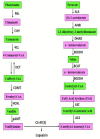Biomedical and Antioxidant Potentialities in Chilli: Perspectives and Way Forward
- PMID: 36234927
- PMCID: PMC9570844
- DOI: 10.3390/molecules27196380
Biomedical and Antioxidant Potentialities in Chilli: Perspectives and Way Forward
Abstract
Worldwide, since ages and nowadays, traditional medicine is well known, owing to its biodiversity, which immensely contributed to the advancement and development of complementary and alternative medicines. There is a wide range of spices, herbs, and trees known for their medicinal uses. Chilli peppers, a vegetable cum spice crop, are bestowed with natural bioactive compounds, flavonoids, capsaicinoids, phytochemicals, phytonutrients, and pharmacologically active compounds with potential health benefits. Such compounds manifest their functionality over solo-treatment by operating in synergy and consortium. Co-action of these compounds and nutrients make them potentially effective against coagulation, obesity, diabetes, inflammation, dreadful diseases, such as cancer, and microbial diseases, alongside having good anti-oxidants with scavenging ability to free radicals and oxygen. In recent times, capsaicinoids especially capsaicin can ameliorate important viral diseases, such as SARS-CoV-2. In addition, capsaicin provides an ability to chilli peppers to ramify as topical agents in pain-relief and also benefitting man as a potential effective anesthetic agent. Such phytochemicals involved not only make them useful and a much economical substitute to wonder/artificial drugs but can be exploited as obscene drugs for the production of novel stuffs. The responsibility of the TRPV1 receptor in association with capsaicin in mitigating chronic diseases has also been justified in this study. Nonetheless, medicinal studies pertaining to consumption of chilli peppers are limited and demand confirmation of the findings from animal studies. In this artifact, an effort has been made to address in an accessible format the nutritional and biomedical perspectives of chilli pepper, which could precisely upgrade and enrich our pharmaceutical industries towards human well-being.
Keywords: Capsicum annuum; TRPV1 receptor; anticancer properties; antioxidants; capsaicin; capsaicinoids; health benefits.
Conflict of interest statement
The authors declare no conflict of interest.
Figures





Similar articles
-
The Multifaceted Chemistry of Chili Peppers: A Biodiversity Treasure for Nutrition and Biomedicine.Chem Biodivers. 2025 Jun;22(6):e202402690. doi: 10.1002/cbdv.202402690. Epub 2025 Feb 14. Chem Biodivers. 2025. PMID: 39898594 Review.
-
Capsicum annuum (hot pepper): An ancient Latin-American crop with outstanding bioactive compounds and nutraceutical potential. A review.Compr Rev Food Sci Food Saf. 2020 Nov;19(6):2972-2993. doi: 10.1111/1541-4337.12634. Epub 2020 Sep 27. Compr Rev Food Sci Food Saf. 2020. PMID: 33337034 Review.
-
Chemical composition and antifungal activity of Capsicum pepper aqueous extracts against plant pathogens and food spoilage fungi.Front Cell Infect Microbiol. 2024 Oct 3;14:1451287. doi: 10.3389/fcimb.2024.1451287. eCollection 2024. Front Cell Infect Microbiol. 2024. PMID: 39421640 Free PMC article.
-
Final report on the safety assessment of capsicum annuum extract, capsicum annuum fruit extract, capsicum annuum resin, capsicum annuum fruit powder, capsicum frutescens fruit, capsicum frutescens fruit extract, capsicum frutescens resin, and capsaicin.Int J Toxicol. 2007;26 Suppl 1:3-106. doi: 10.1080/10915810601163939. Int J Toxicol. 2007. PMID: 17365137 Review.
-
Naga chilli: a potential source of capsaicinoids with broad-spectrum ethnopharmacological applications.J Ethnopharmacol. 2010 Oct 28;132(1):1-14. doi: 10.1016/j.jep.2010.08.034. Epub 2010 Aug 20. J Ethnopharmacol. 2010. PMID: 20728519 Review.
Cited by
-
Evolving Strategies for Use of Phytochemicals in Prevention and Long-Term Management of Cardiovascular Diseases (CVD).Int J Mol Sci. 2024 Jun 4;25(11):6176. doi: 10.3390/ijms25116176. Int J Mol Sci. 2024. PMID: 38892364 Free PMC article. Review.
-
Genetic Diversity of a Heat Activated Channel-TRPV1 in Two Desert Gerbil Species with Different Heat Sensitivity.Int J Mol Sci. 2023 May 23;24(11):9123. doi: 10.3390/ijms24119123. Int J Mol Sci. 2023. PMID: 37298074 Free PMC article.
-
Red chili powder dietary supplementation regularized the performance, hematobiochemical indices, oxidative status, and 8-hydroxy-2'-deoxyguanosine of aflatoxin B1 exposed broiler chickens.Transl Anim Sci. 2024 Jan 11;8:txae006. doi: 10.1093/tas/txae006. eCollection 2024. Transl Anim Sci. 2024. PMID: 38313223 Free PMC article.
-
Long-Term Capsaicin Administration Ameliorates the Dysfunction and Astrogliosis of the Brain in Aged Mice with Missing Maxillary Molars.Nutrients. 2023 May 25;15(11):2471. doi: 10.3390/nu15112471. Nutrients. 2023. PMID: 37299434 Free PMC article.
-
Extraction and Optimization of Lycopene From Selected Fruits and Their Assessment as an Ultraviolet Ray Protectant for Escherichia coli.Food Sci Nutr. 2025 Apr 18;13(4):e70090. doi: 10.1002/fsn3.70090. eCollection 2025 Apr. Food Sci Nutr. 2025. PMID: 40255559 Free PMC article.
References
-
- Bosland P.W. Progress in New Crops. Academic Press; Arlington, VA, USA: 1996. Capsicum: Innovative uses of an ancient crop; pp. 479–487.
-
- Mercy A.G., Light W.F., Gospel S.A. Qualitative and quantitative phytochemical screening of some plants used in ethnomedicine in the Niger Delta region of Nigeria. J. Food Nutr. Sci. 2017;5:198–205.
-
- Bal S., Maity T.K., Sharangi A.B., Maji A. Screening of onion (Allium cepa L.) germplasm against purple blotch disease. J. Pharmacogn. Phytochem. 2019;8:546–548.
-
- Bal S., Maity T.K., Sharangi A.B., Majumdar A. Quality assessment in association with yield attributes contributing improved yield in onion (Allium cepa L.) J. Crop Weed. 2019;15:107–115. doi: 10.22271/09746315.2019.v15.i3.1245. - DOI
Publication types
MeSH terms
Substances
LinkOut - more resources
Full Text Sources
Miscellaneous

